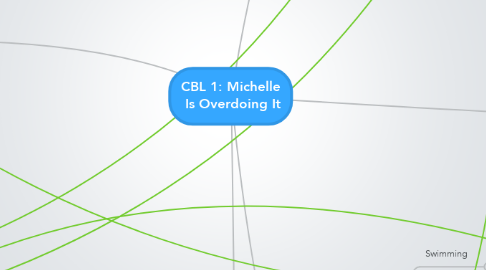
1. Swimmers' Shoulder
1.1. Definition
1.1.1. Shoulder pain that typically occurs in competitive swimmers
1.1.2. Several causes, including rotator cuff tendonitis
1.1.3. Unnatural usage of shoulder puts lots of stress on shoulder
1.1.4. Also called impingement syndrome
1.1.5. Tedonopathy
1.2. Prevalence
1.2.1. Non-consistent statistics, from 3% to 80% of all swimmers
1.2.2. Is hard to have accturate figures which include amateur swimmers and consider varying levels of pain tolerance
1.3. Incidence
1.3.1. Sources vary from 30% to 30%, or 47% - 73% for high level/compeditive swimmers
1.4. Complications
1.4.1. Progression
1.4.1.1. Rotator cuff degeneration
1.4.1.2. Rotator cuff tear
1.4.2. Latrogenic Complications
1.4.2.1. Septic arthritis
1.4.2.2. NSAID GI adverse effects
1.4.3. Other
1.4.3.1. Recurrance
1.4.3.2. Adhesive capsulits
1.4.3.3. Cuff tear arthropathy
1.4.3.4. Reflex sympathy dystrophy
1.5. Prognosis
1.5.1. Good as long as rest occurs
1.5.2. 3-6 weekly assessment
1.5.3. Some cases require surgery
1.6. Causes
1.6.1. Commonly with rotator cuff muscles
1.6.2. Swimming puts lots of stress on shoulder
1.6.3. Incorrect technique will push humerus up and forwards, pinching shoulder joint structures
1.6.4. Tendons and bursae are especially vulnerable
1.6.5. Incorrect freestyle technique impinges long bicep tendon against coracoacromial arch
1.6.6. Rotator cuff muscle too tired from overuse
1.6.7. If situation remains uncorrected...
1.6.7.1. Rotator cuff tendonitis
1.6.7.2. Bursitis
1.6.7.3. Tear muscles
1.6.8. Impingement
1.6.8.1. Sudden changes to intensity
1.6.8.2. Overuse
1.6.8.3. Uneven development of muscle
1.6.8.4. Weakness and tightness in rotator cuff muscles
1.7. Risk Factors
1.7.1. Over 30
1.7.2. Arm consistently in overhead position
1.7.3. Heavy training schedules
1.7.4. Overreaching swimming stroke
1.7.5. Previous injury
1.7.6. Muscle fatigue
1.7.7. Conditions affecting the schoulder
1.7.8. Use of equipment, placing strain on shoulder
1.8. Treatment
1.8.1. Pain relief
1.8.1.1. Resting, reducing/stopping sport
1.8.1.2. Apply ice daily
1.8.1.3. Anti-inflammatories
1.8.1.3.1. Ibuprofen- 400mg every 8 hours
1.8.2. Restoring Strength
1.8.2.1. Physio exercises
1.8.2.2. Reduce pain and imflammation
1.8.2.2.1. Ultrasound
1.8.2.2.2. Phonophoresis
1.8.2.2.3. Iontophorses
1.8.2.2.4. Electrical stimulation
1.8.2.2.5. Cortisone as short-term option
1.8.3. Surgery
2. Clinical
2.1. History
2.1.1. Determine chief symptom
2.1.1.1. From certain event or repeated motion
2.1.1.2. Associated Sypmtoms
2.1.1.2.1. Swelling Numbness Tenderness in AC joint or coracoid Mild winging of scapula Forward shoulder slouch while seated Tenderness in adjacent bicep and Supraspinatus tendons Slightly reduced strength in supra- and infraspinatus Moderate posterior and anterior laxity in both shoulder
2.1.1.3. Worse at night and overhead activity
2.1.2. PMx
2.1.2.1. Physical therapy
2.1.2.2. Sugery
2.1.2.3. Previous injections
2.1.3. Drugs
2.1.3.1. Previous treatments
2.1.3.2. Use of ice, heat, medication
2.1.4. Social
2.1.4.1. Occupation
2.1.4.2. Sport and level of athletic participation
2.2. Inspection
2.2.1. Look for atrophy
2.2.1.1. Supraspinatus fossa
2.2.1.2. Infraspinatus fossa
2.2.1.3. Deltoid
2.3. Palpation
2.3.1. Acromioclavicular joint
2.3.2. Rotator cuff bursa
2.4. Range of motion
2.4.1. Forward elevation
2.4.2. Internal rotation
2.4.3. External rotation
2.5. Special tests
2.5.1. Positive Neer's test
2.5.2. Positive Hawkin's test
2.5.3. Negative 'empty the beer can' test
3. Michelle
3.1. 19 years old Female
3.2. Swimming
3.2.1. Has swum for 7 years
3.2.2. Training increase to 4 hours
3.2.3. Involved and supportive parents
3.3. Office Worker
3.4. Psychosocial
3.4.1. Both parents
3.4.2. Under financial constraints possibly - treatment cost is concern
3.4.3. Workplace is flexible
3.5. Presenting Complaint
3.5.1. Right shoulder pain for 3 weeks
3.5.2. Throbbing after training and during the night
3.5.3. Losing sleep, worried
3.5.4. Pain getting progressively worse
3.5.5. Affecting sprint times
3.5.6. Diagnosed as Swimmers' Shoulder
4. Issues
4.1. Swimming
4.1.1. Effect on training/competing/selection, her swimming goals and dreams
4.1.2. Possibly inability to continue swimming at all
4.1.3. Passion for swimming vs complying to treatment
4.1.4. Her age and limitations of competitive swimming
4.1.5. Expectations for returning to swimming
4.1.6. Risk of re-injury
4.2. Financial
4.2.1. Cost of medial attention
4.2.1.1. Delay in treatment
4.2.1.2. Quick-fix option
4.2.2. Sources of income
4.2.2.1. Sick leave from work
4.2.2.2. Parent/Family?
4.2.3. Sense of wasting money if cannot continue swimming
4.3. Mental Heath
4.3.1. High invested in swimming- emotional impact of losing it, anger, upset, guilt, depression, losing motivation, feeling lost
4.3.2. Pain of injury -> depression
4.3.3. Losing sleep from the pain can affect relationships, mood, coping and functioning
4.3.4. Swimming as exercise, relaxation and hobby, how to cope if those were lost
4.3.5. Parents, friends and coaches as support
4.3.6. Burnout is possible due to emotional and physical stress
5. Pain
5.1. Chronic Pain
5.1.1. Interfers with daily activities
5.1.2. Lack of sleep
5.1.3. Decreased ability to focus/work
5.1.4. Anxiety and depression
5.1.5. Injury is leading cause
5.1.6. Management is key
5.1.6.1. Consider holistic approach
5.1.6.2. Financial status
5.1.6.3. Medications
5.1.7. Problematic when patients have demanding careers
5.2. Types of pain
5.2.1. Nociceptive/Somatic Pain
5.2.1.1. Pain related to tissue damage
5.2.1.2. Stimuli of harmful or near harmful intensity
5.2.1.3. Modulated by neurotransmitters and psychological processes
5.2.2. Neuropathic Pain
5.2.2.1. Damage to PNS or CNS
5.2.2.2. Pain can be independent to original injury
5.2.2.3. Can be normally non-painful stimuli
5.2.3. Psychogenic and Idiopathic Pain
5.2.3.1. Psychogenic: Factors influencing patient's perception of pain
5.2.3.2. Idiopathic: No clear/identifiable cause
